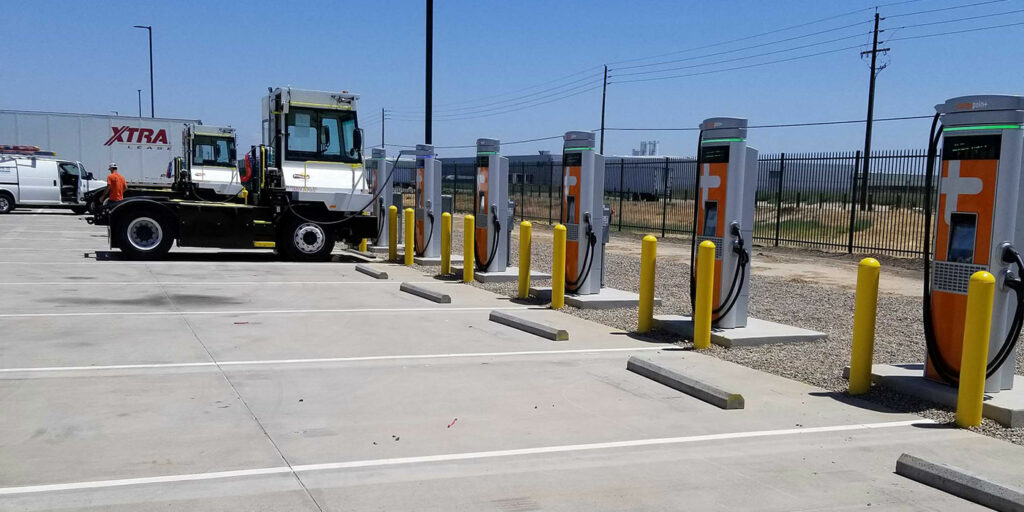Clarity is finally coming to commercial electric truck charging infrastructure decisions. With electric trucks available for order and on their way to delivery, the application of those trucks has been demystified. As more fleets put in charging infrastructure, the process will become more apparent and approachable. Here at Fleet Equipment, we’ve charted the charging station OEMs options and talked with truck OEMs about the infrastructure installation process. For our next act, we’re breaking it down in easy-to-understand terms.
Or, more accurately, Rich Mohr, global vice president fleet at ChargePoint, an electric vehicle charging network, puts the charging infrastructure challenge into easy-to-understand terms. Prior to joining ChargePoint, Mohr spent 25 years at Ryder Systems Inc., so he brings a fleet-focused, brass-tacks approach to electric infrastructure installation and usage. It starts with three main questions that fleets need to answer when starting the electric charging infrastructure conversation.
- Do you need visibility of what’s going on with your fleet and with your chargers?
- Do you need access to your fleet and to your chargers to be able to control things?
- Do you need control over what’s happening in your fleet?
“Visibility, access and control—those are all things that are important to fleets. They’re looking at, ‘Can I integrate my telematics? How do I know when the drivers are back?’ Those are issues they are trying to solve with their diesel fleets right now. They run into the same thing,” Mohr said.
It doesn’t matter if you’re running delivery applications and vehicles are charging at your homebase or if they’re charging at a depot, you still need visibility, access and control. Luckily, in the early days of electric truck adoption, chances are that the application is the former rather than the latter.
“We know 90% of the charging is going to be done via return-to-home every day,” Mohr said. “They’re running predictable routes, and there’s distinct advantages around those fleets that return home every night. We think that 70% of electric fleets are going to need visibility, access and control—to be able to manage their power, manage their vehicles, and have notifications and all the things that a normal fleet customer would have through their telematics service provider.”
The technology and equipment might be different, but the approach is the same: “The way I’ve been going to fleets in North America is by saying, ‘Let’s talk about how you run your business,” Mohr said.
Of course, all of this assumes that fleets understand their electric truck return on investment. Reaping that ROI is a delicate balance of up-front costs of electric trucks and infrastructure and potentially longer-term electric truck lifecycles and drastically reduced maintenance costs. Much of that TCO leg-work will be done working with your OEM of choice.
Once you have the answers to the above questions, now you can start digging into charging infrastructure choices.
For those about to rock (electric trucks): AC/DC and charging best practices
When it comes to charging, Mohr notes: Slower is better.
“Regardless of whether it’s AC or DC power, when you have dwell time, slower is always better. It’s more cost-effective from a hardware standpoint, and it’s more cost-effective from an electric standpoint,” he explained, then he dove into the AC/DC power selection considerations.
AC Power
• Provides an electrical current of 16 to 80 amps.
• AC charging tops out at about 19 kilowatts (kW)
• Standard building wiring can typically support an AC charger.
DC Power
• Typically starts above 20 (kW) but the average deployment is 50 (kW) and above.
• Can support fast charging. In ChargePoint’s case, its EXPP Power Block houses up to five self-contained EXPP Power Modules that can flexibly distribute up to 200 kW, for example.
• Requires additional on-site investment in electrical infrastructure to support energy from utilities.
“Whether vehicles are charging on an AC charging station or a DC fast charging station, in both cases, the vehicle controls the flow of energy to the battery,” Mohr explained. “The difference is that the power conversion, AC to DC, happens on-board the vehicle for AC charging, whereas with DC charging, the AC to DC power conversion happens in the charging station.”
Mohr noted that many lighter-duty vehicles come standard with AC charging because they typically have smaller batteries and will support lower power charging for most situations needed in fleet operations.
When you start talking about fast-charging, that’s DC power—you’re talking about 150 kW, 200 kW and beyond. Mohr also noted that some vehicles offer both AC and DC charging options.
Charging software challenges
This is where the fun begins. Parsing through the application needs and equipment options is pretty straightforward and relatable to typical fleet equipment acquisition conversations. However, electric truck charging isn’t a simple fueling process where you pull the pump, put the nozzle in and let it fill. Software brings a large degree of intelligence to the process, enabling fleet managers to keep tabs on electric fueling costs.
To start, you need to be comfortable talking about software inoperability testing. Here are the basics: Not all OEM charging software is created equal. Different OEMs employ software solutions specific to their equipment. (Think about it in the same way that different engine manufacturers have proprietary engine software to control their power plants.) A charging station’s software needs to be able to interact with the specific truck software.
“ChargePoint, and a lot of other charging companies, test every OEM vehicle that comes into the marketplace, and we test all levels of our chargers—from AC to DC,” Mohr said. “We do an inoperability test on all of them. Not just to see if the charger works, but: Does it work under all use cases?
“Does it work under the case where you’re trying to balance energy?” he continued rattling off use cases. “Does it work under the case where you have a fault code on the vehicle? Does it work under the case if you lose power and the charger has to restart remotely?
“We test all the different situations with that charger and the vehicle to make sure the two are paired. You’ll find that a lot of our chargers are sitting at the OEMs, along with other chargers. That’s for the purpose of doing inoperability testing across the network, so that the vehicles work properly together.”
And it’s a moving target. As we all know by now, software is updated constantly. This will be the case for OEM on-truck charging software just as it currently is for on-engine software. With the advent of over-the-air updates in the diesel world, you can be sure that process is coming to electric trucks. Charging station software will need similar software update support to ensure operability between the charger and the truck.
What’s next?
This primer should be enough to get you started. If you’re ready to take the next step, here is a useful related story:













